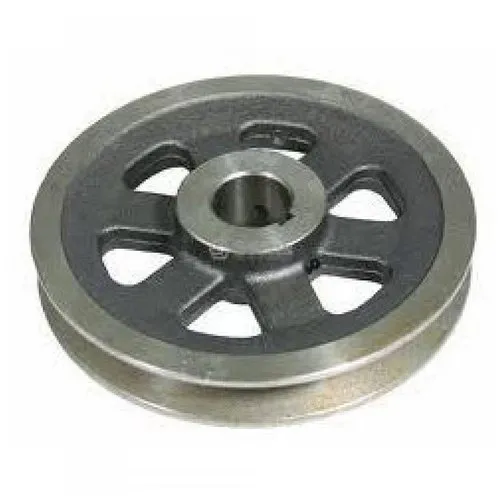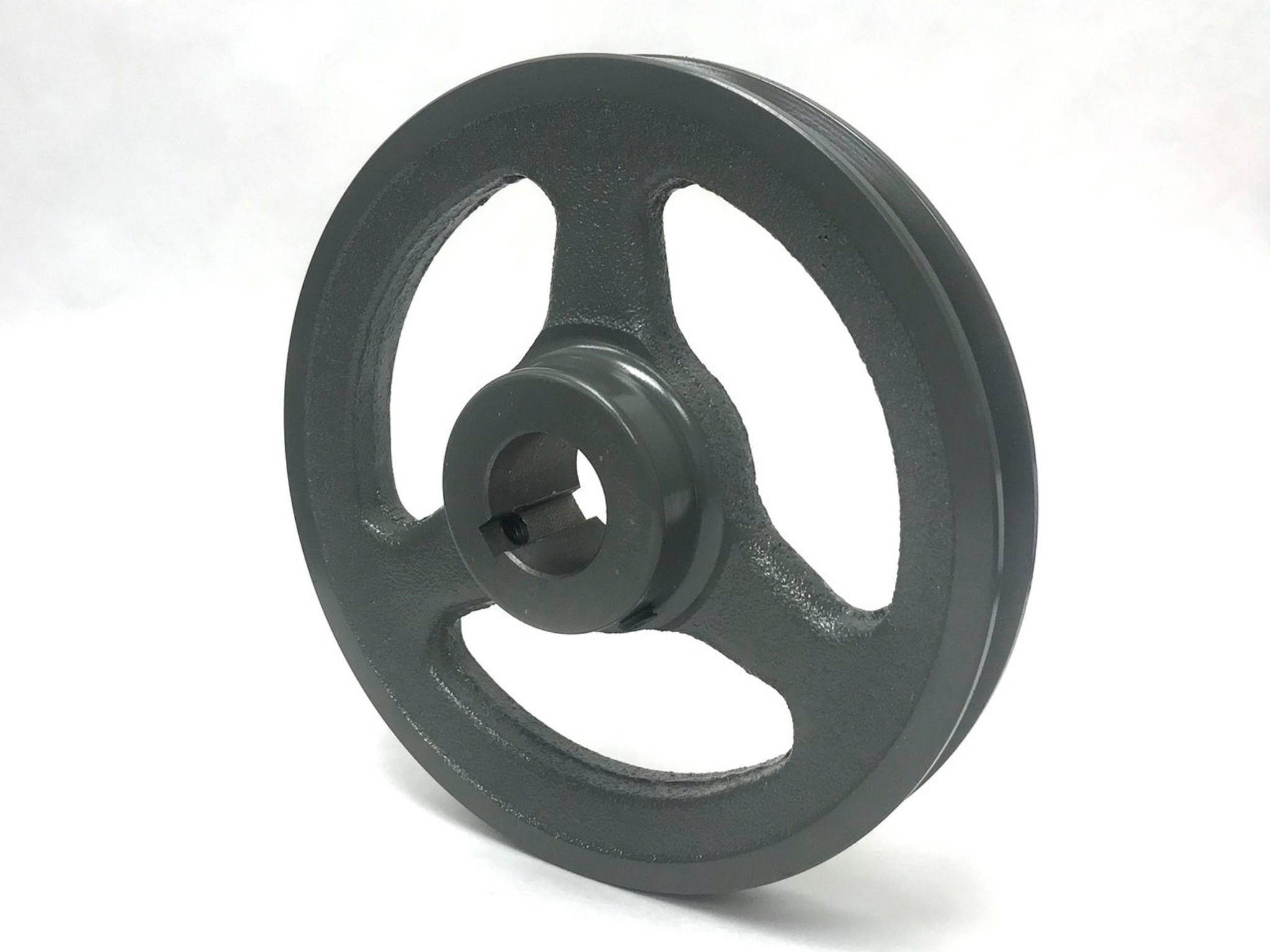Product Description
OEM Foundry CHINAMFG Cast Iron V Belt Pulley with Machining
1 Material: cast iron, usually gg20 and gg25
2 Surface treatment: usually RAL2004
3 Groove sections A, B, and C.
4 Diamater:80-290
V belt pulley specifications:
1) European standard:
a) V-belt pulleys for taper bushings: SPZ, SPA, SPB, SPC; up to 10 grooves
b) Adjustable speed V-belt pulleys and variable speed pulleys
c) Flat belt pulleys and conveyor belt pulleys
2) American standard:
a) Sheaves for taper bushings: 3V, 5V, 8V
b) Sheaves for QD bushings: 3V, 5V, 8V
c) Sheaves for split taper bushings: 3V, 5V, 8V
3) Bore: pilot bore, finished bore, taper bore, bore for QD bushing
4) Surface finish: paint, phosphating, zinc plated
5) Material: cast iron, ductile iron, nylon, aluminum
6) Made according to drawings and/or samples, OEM inquiries welcomed
| Item | Description | Material | Technical Process |
| 1 | Ductile iron castings | ASTM A 536-Gr.60-40-18, 65-45-12 | Green-sand moulding |
| DIN-GGG40, GGG50, GGG60, GGG70 | Resin-sand moulding | ||
| JIS-FCD40, FCD50, FCD60, FCD70 | Lost foam cast | ||
| BS-Gr370-17,Gr420-12, Gr500-7 | Shell-core cast | ||
| NF-FGS370-12, FGS400-12, FGS500-7 | Electric-furnace smelting | ||
| 2 | Grey iron castings | ASTM A48-No.20,25,30,35,40,45 | Green-sand moulding |
| ASTM A126-Class A, Class B, Class C | Resin-sand moulding | ||
| DIN-GG10, GG15, GG20, GG25, GG30 | Lost foam cast | ||
| JIS-FC10, FC15, FC20, FC25, FC30, FC35 | Shell-core cast | ||
| BS-Grade 150, 180, 220, 260, 300, 350 | Electric-furnace smelting | ||
| NF-FGL150, FGL200, FGL250, FGL300 | |||
| 3 | Carbon steel castings | ASTM A216-Cr. WCB. Cr. WCA, Gr. WCC | Soluble glass sand moulding |
| ASTM-415-205, 450-240, 485-275, 80-40 | Resin-sand moulding | ||
| DIN-GS-C25, GS-38, GS-45, GS-52 | Lost wax casting | ||
| JIS-SC410, SC450, SC480,SCC5 | Lost foam cast | ||
| NF-GE230, GE280, GE320, GE370 | Shell-core cast | ||
| Electric -furnace smelting | |||
| 4 | Stainless steel castings | ASTM-CF-8M,CF-8, CA-15, CA-40,316, | Soluble glass sand moulding |
| DIN-G-X6 CrNi18 G-X7Cr13 | Resin-sand moulding | ||
| JIS-SCS13, SCS1, CHINAMFG 2, CHINAMFG 14A | Lost wax casting | ||
| BS-304 C15, 410C21, 420C29, 316 | Lost foam cast | ||
| NF-Z6CND18.12M, Z6CN18.10M,Z12C13 | Shell-core cast | ||
| Electric -furnace smelting | |||
| 5 | Alloy steel castings | DIN-GS-40Mn5, GS-20Mn5, GS-37MnSi5 | Soluble glass sand moulding |
| JIS-SCMn3, SCW480, SCSiMn2,SCCrM3 | Resin-sand moulding | ||
| ASTM-LCC | Lost wax casting | ||
| UNS-J57105, J13048 | Lost foam cast | ||
| NF-G20M6, G35CrMo4 | Shell-core cast | ||
| Electric -furnace smelting |
/* January 22, 2571 19:08:37 */!function(){function s(e,r){var a,o={};try{e&&e.split(“,”).forEach(function(e,t){e&&(a=e.match(/(.*?):(.*)$/))&&1
| Application: | Machinery Parts |
|---|---|
| Machining: | CNC Machining |
| Material: | Cast Iron |
| Standard: | AISI |
| Certification: | ISO 9001:2008 |
| Transport Package: | Case |
| Samples: |
US$ 1/Piece
1 Piece(Min.Order) | |
|---|
| Customization: |
Available
| Customized Request |
|---|

What role do cast pulleys play in the manufacturing of automobiles?
Cast pulleys play a significant role in the manufacturing of automobiles, contributing to the functionality and efficiency of various systems within the vehicles. They are utilized in multiple applications, ranging from the engine to the drivetrain and auxiliary systems. Here’s a detailed explanation of the role cast pulleys play in the manufacturing of automobiles:
- Engine Components: Cast pulleys are commonly used in engine systems, particularly in the accessory drive system. They are employed in the engine’s serpentine belt or V-belt drive system to transmit power from the crankshaft to various components, such as the alternator, water pump, power steering pump, and air conditioning compressor. Cast pulleys provide the necessary mechanical advantage and enable efficient power transfer, ensuring the proper functioning of these engine accessories.
- Timing Systems: Cast pulleys are integral to the timing systems in automobiles. Timing belts or timing chains, along with cast pulleys, synchronize the rotation of the engine’s camshaft(s) and crankshaft, ensuring precise valve timing and proper engine operation. The cast pulleys in the timing system guide and support the timing belt/chain, maintaining tension and facilitating smooth and accurate timing belt/chain movement. This is crucial for the overall performance and reliability of the engine.
- Powertrain: Cast pulleys are employed in the powertrain systems of automobiles, contributing to the transmission and drivetrain operations. In vehicles with belt-driven continuously variable transmissions (CVTs), cast pulleys are used in the CVT system to vary the gear ratio and provide smooth power delivery. Additionally, in some manual transmissions, cast pulleys may be utilized in the clutch mechanism to engage and disengage the engine power from the transmission.
- Accessory Systems: Cast pulleys are also utilized in various accessory systems within automobiles. For example, they can be found in the HVAC (Heating, Ventilation, and Air Conditioning) system, where they help drive components such as the blower motor or compressor. Cast pulleys ensure efficient power transmission, enabling the proper functioning of these accessory systems and enhancing overall comfort and convenience for the vehicle occupants.
- Suspension Systems: In some automobile suspension systems, cast pulleys play a role in the operation of self-leveling systems or adjustable suspension components. Cast pulleys, along with cables or belts, can be used to adjust the suspension height or tension, allowing for dynamic suspension adjustments depending on driving conditions or user preferences.
- Other Applications: Cast pulleys may have additional applications in automobiles, depending on the specific vehicle and its systems. They can be employed in power steering systems, fuel injection systems, cooling systems, or auxiliary systems that require power transmission or tensioning mechanisms.
In summary, cast pulleys are used in the manufacturing of automobiles to support various systems and components. They play a crucial role in engine accessory drives, timing systems, powertrain operations, accessory systems, suspension systems, and other applications. Cast pulleys contribute to the efficient power transmission, reliable operation, and overall functionality of automotive systems, ensuring optimal performance and driving experience for vehicle owners.

How does the casting process affect the quality of pulleys?
The casting process plays a crucial role in determining the quality of pulleys. The casting technique used, along with various factors related to the process, can significantly impact the final quality and performance of the pulleys. Here are some ways in which the casting process affects the quality of pulleys:
- Material Integrity: The casting process ensures the integrity of the material used for the pulley. It allows for the precise control of the composition and metallurgical properties, ensuring that the pulley material meets the required strength, hardness, and other mechanical properties. Proper material selection and control during casting contribute to the overall quality and durability of the pulley.
- Dimensional Accuracy: Casting enables the production of pulleys with precise dimensional accuracy. Through careful mold design and control over the casting process parameters, it is possible to achieve tight tolerances and accurate replication of the pulley’s geometry. Dimensional accuracy is essential for proper belt or chain alignment, smooth operation, and effective power transmission.
- Surface Finish: The casting process affects the surface finish of the pulleys. Proper mold design, gating system, and casting techniques help minimize surface defects such as porosity, shrinkage, or roughness. A smooth and defect-free surface finish is important for reducing friction, ensuring proper belt or chain engagement, and preventing premature wear or damage to the power transmission components.
- Mechanical Strength: The casting process influences the mechanical strength of the pulleys. Proper cooling rates, controlled solidification, and heat treatment techniques during casting can enhance the pulley’s strength and toughness. This is crucial to withstand the forces and stresses involved in power transmission, ensuring a reliable and safe operation of the machinery.
- Consistency and Reproducibility: The casting process allows for consistent and reproducible production of pulleys. Once the casting parameters are optimized and the mold is prepared, the process can be repeated to produce pulleys with consistent quality and performance. This is particularly important for industries that require multiple pulleys with identical specifications for equipment standardization and interchangeability.
- Quality Control: The casting process involves various quality control measures to ensure the desired quality of pulleys. This includes inspection and testing of the casting materials, monitoring of process parameters, and non-destructive testing of the finished pulleys. Quality control measures help identify any defects, ensure compliance with specifications, and improve the overall quality and reliability of the pulleys.
In summary, the casting process directly impacts the quality of pulleys by influencing material integrity, dimensional accuracy, surface finish, mechanical strength, consistency, and reproducibility. By employing appropriate casting techniques, controlling process parameters, and implementing effective quality control measures, manufacturers can produce high-quality pulleys that meet the requirements of power transmission applications in various industries.

What are the key characteristics of a cast pulley’s construction?
A cast pulley is a type of pulley that is manufactured through the casting process, which involves pouring molten metal into a mold and allowing it to cool and solidify. The construction of a cast pulley exhibits several key characteristics:
- Material: Cast pulleys are typically made from durable materials such as cast iron, cast steel, or cast aluminum. These materials offer high strength and resistance to wear and corrosion, making them suitable for various industrial applications.
- Shape and Design: Cast pulleys come in a variety of shapes and designs depending on their intended use. Common shapes include flat, V-shaped, and grooved pulleys. The design may also feature spokes or arms to enhance structural integrity and reduce weight.
- Machined Surfaces: After the casting process, the surfaces of the cast pulley are machined to achieve precise dimensions and smooth finishes. This ensures proper alignment and reduces friction with belts or ropes that run on the pulley.
- Bore and Shaft Fit: Cast pulleys have a central bore or hub where they are mounted onto a shaft. The bore is typically machined to achieve a precise fit with the shaft, ensuring a secure connection and efficient power transmission.
- Reinforcement: In some cases, cast pulleys may be reinforced with additional components to enhance their strength and durability. This can include the addition of ribs, flanges, or other structural elements that provide extra support and prevent deformation under heavy loads.
- Balance: Proper balance is crucial for the smooth operation of a pulley system. Cast pulleys are carefully balanced during the manufacturing process to minimize vibration and reduce stress on the pulley, shaft, and associated components.
- Mounting and Fixing: Cast pulleys are designed to be easily mounted and fixed in place. They may have keyways, set screws, or other mechanisms to secure them to the shaft and prevent slipping or rotation during operation.
Overall, the construction of a cast pulley involves selecting suitable materials, casting the pulley shape, machining the surfaces, ensuring proper fit with the shaft, reinforcing as needed, balancing the pulley, and providing mechanisms for secure mounting. These characteristics collectively contribute to the reliability, efficiency, and longevity of cast pulleys in various industrial and mechanical applications.


editor by CX
2024-04-30